The search for the W boson
Construction begins on the Super Proton Synchrotron (SPS)
The Super Proton Synchrotron is designed to…
Know more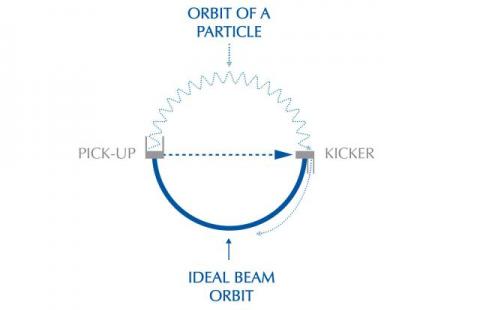
Simon van der Meer writes about stochastic cooling
Simon van der Meer at CERN writes a paper…
Know more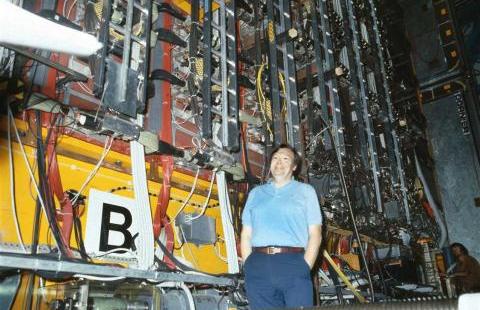
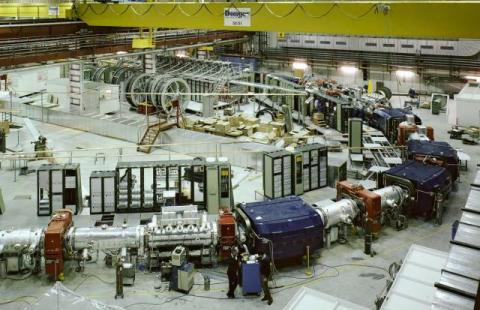
First injection of protons into the Antiproton Accumulator
Proton beams are injected and stored for the…
Know moreFirst acceleration of antiprotons in the SPS
The Super Proton Synchrotron (SPS) accelerates…
Know moreFirst proton-antiproton collision in the SPS
Carlo Rubbia delays his departure to the Lisbon…
Know more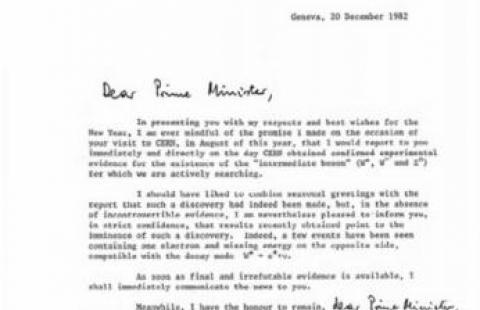
Director-General Schopper writes to Thatcher: Discovery imminent
The first person outside CERN to be informed of…
Know more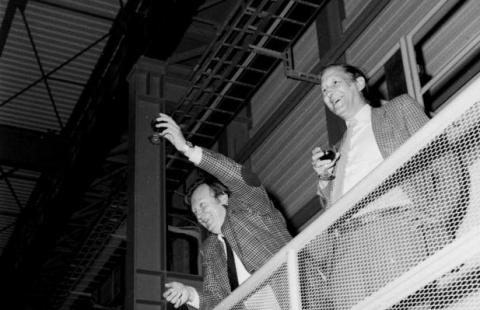
Embed this timeline
Construction begins on the Super Proton Synchrotron (SPS)
The Super Proton Synchrotron is designed to provide protons at 400 GeV for fixed-target experiments. Construction for this underground synchrotron begins on 19 February 1971.
Simon van der Meer writes about stochastic cooling
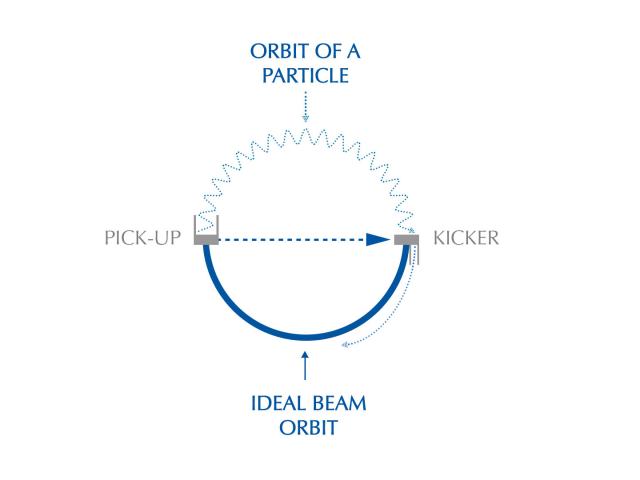
Simon van der Meer at CERN writes a paper describing a technique he had first though of in 1968 to reduce the energy spread and angular divergence of a beam of charged particles. During this process of "stochastic cooling", the particles are "compressed" into a finer beam with less energy spread and less angular divergence. By increasing the particle density to close to the required energy, this technique improved the beam quality and, among other things, brings the discovery of the W boson within reach.
The SPS: From accelerator to collider
At the International Neutrino Conference in Aachen, Germany, (8-12 June 1976) physicists Carlo Rubbia, Peter McIntyre and David Cline suggest modifying the Super Proton Synchrotron (SPS) from a one-beam accelerator into a two-beam collider. The two-beam configuration would collide a beam of protons with a beam of antiprotons, greatly increasing the available energy in comparison with a single beam colliding against a fixed target.
Their paper on the subject, Producing Massive Neutral Intermediate Vector Bosons with Existing Accelerators is published in the conference proceedings the following year.
SPS reaches its design energy of 400 GeV
At 2.2 kilometres in diameter the Super Proton Synchrotron is Europe's largest particle accelerator. Commissioning of the accelerator begins in mid-March 1976 using beams of protons. Then on 17 June 1976 the SPS accelerates a beam of protons at its design energy of 400 GeV for the first time. The machine is ready to supply beams to experiments.
UA1 experiment approved
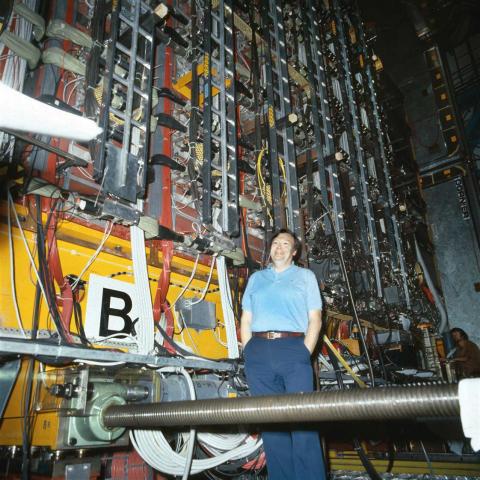
CERN physicist Carlo Rubbia pulls together a team to put forward a proposal for an experiment code-named UA1, for "Underground Area 1", since its location on the SPS requires a large cavern to be excavated. The team grows to involve some 130 physicists from 13 research centres – Aachen, Annecy LAPP, Birmingham, CERN, Helsinki, Queen Mary College London, Collège de France Paris, Riverside, Rome, Rutherford, Saclay, Vienna and Wisconsin. On 29 June 1978, the CERN Research Board accepts the proposal for a huge "general purpose" detector to record proton-antiproton collisions at 540 GeV.
The weak side of the force
Three physicists, Steven Weinberg, Abdus Salam and Sheldon Glashow, receive the Nobel prize in physics for proposing the electroweak theory. They believe that two of the four fundamental forces – the electromagnetic force and the weak force – are in fact different facets of the same force. Under high-energy conditions such as those in a particle accelerator, the two would merge into the electroweak force. But three hypothetical force-carrier particles described by the theory have yet to be confirmed in experiments: the W+, W- and Z0 bosons. These are heavy particles; so finding them would require an accelerator that could reach an unprecedented level of energy.
First injection of protons into the Antiproton Accumulator

Proton beams are injected and stored for the first time in the Antiproton Accumulator – a storage ring invented by CERN physicist Simon van der Meer where stochastic cooling produces intense antiproton beams. It took only two years from authorization of the machine to the announcement of first operation at the International Accelerator Conference at CERN, in July 1980. Within days, magnet polarities are reversed and antiprotons are injected and cooled.
First acceleration of antiprotons in the SPS
The Super Proton Synchrotron (SPS) accelerates its first pulse of antiprotons to 270 GeV. Two days later, with a proton beam orbiting in the opposite direction, there is the first evidence of proton-antiproton collisions. In August, the antiproton count reaches 109 and the UA1 calorimeter records some 4000 events. In October, the first visual evidence of the collisions is recorded in the streamer chambers of the UA5 detector (a precursor to UA2).
First proton-antiproton collision in the SPS
Carlo Rubbia delays his departure to the Lisbon High Energy Physics Conference by a day so that on 10 July 1981, he is able to announce that the UA1 detector has seen its first proton-antiproton collisions. UA2 takes its first data in December this same year.
Director-General Schopper writes to Thatcher: Discovery imminent
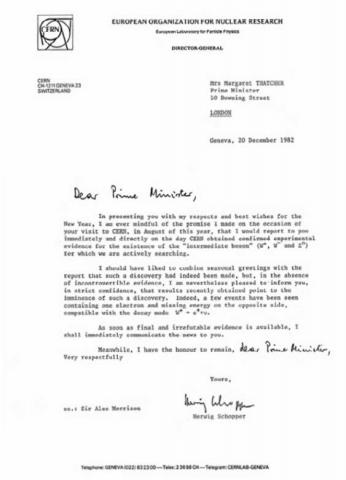
The first person outside CERN to be informed of the imminent discovery of the W boson is Margaret Thatcher, then Prime Minister of the United Kingdom, who paid a visit to CERN in August 1982. [See a video of the visit]. During her visit Thatcher asked the then Director-General of CERN Herwig Schopper to keep her updated on the progress of the search for the carriers of the weak force, the W and Z bosons.
In a confidential letter dated 20 December 1982, Schopper wrote:
"I am ever mindful of the promise I made on the occasion of your visit to CERN…that I would report to you immediately and directly on the day CERN obtained confirmed experimental evidence of the 'intermediate boson' (W+, W- and Z0) for which we are actively searching. …I am…pleased to inform you, in strict confidence, that the results recently obtained point to the imminence of such a discovery…"
Signs of a W particle
At the Topical Workshop on Proton-Antiproton Collider Physics in Rome from 12-14 January 1983, the first tentative evidence for observations of the W particle by the UA1 and UA2 collaborations is presented.
Out of the several thousand million collisions recorded, a handful give signals, which could correspond to the production of a W in the high-energy collision and its subsequent decay into an electron (or positron if the W is positively charged) and a neutrino
Reaching the goal
The tension at CERN becomes electric, culminating in two seminars, from Carlo Rubbia (for UA1) on 20 January 1983 and Luigi Di Lella (for UA2) the following afternoon, both with the CERN auditorium packed to the roof. UA1 announces six candidate W events; UA2 announces four. The presentations are still tentative and qualified.
The discovery of a W particle
In a press conference on 25 January, CERN announces news of the discovery of the W boson to the world. The UA2 team reserves judgment at this stage but further analysis soon convinces them. From their results both teams estimate the boson's mass at around 80 GeV, which is in excellent agreement with predictions from electroweak theory.
Two CERN researchers, one Nobel prize

The discovery of the W boson is so important that the two key physicists behind the discovery receive the Nobel prize in physics in 1984. The prize goes to Carlo Rubbia (pictured, left), instigator of the accelerator’s conversion and spokesperson of the UA1 experiment, and to Simon van der Meer (pictured, right), whose technology is vital to the collider’s operation.
The discovery of the W boson is a significant achievement in physics that further validates the electroweak theory. It also helps to secure the decision to build CERN’s next big accelerator, the Large Electron Positron Collider, whose job is to mass-produce Z and W bosons for further studies.